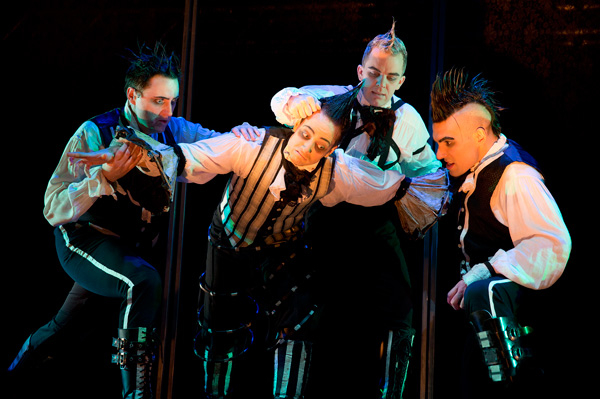Nevermore — The Imaginary Life and Mysterious Death of Edgar Allan Poe

(© Joan Marcus)
You may think you're about to see something spectacular as you take your seat for Nevermore — The Imaginary Life and Mysterious Death of Edgar Allan Poe. The peppy and overproduced preshow music sounds like what you might hear waiting in line at an amusement park. It's easy to feel jazzed. That excitement soon fades, however, when the real show begins.
The musical (which ran briefly ran at New York's New Victory Theater in 2010) has returned to New York for an extended showing at New World Stages. Written, composed, and directed by Canadian theater-maker Jonathan Christenson, Nevermore has an uncommon unity of vision in its look and sound. Unfortunately, this highly distinctive style might also be the source of the show's blandness.
Loosely based on the life of Edgar Allan Poe, Nevermore charts the unhappy existence of America's grimmest poet. He's born into a family of neglectful actors and alcoholics. After the death of his mother (Lindsie VanWinkle), he's sent to live with cruel Scottish merchant Jock Allan (Garett Ross) and his soon-to-be-insane wife, Fanny (Beth Graham). He falls in love with Elmira Royster (Shannon Blanchet) at their favorite teenage hangout (a graveyard), but she weds another man while Poe is away at college. Things seem to be looking up when he marries his cousin Sissy (Beth Graham) and attracts the praise of literary critic Rufus Griswold (Ryan Parker), but he can't seem to shake his inherited taste for cheap bourbon. Meanwhile, everyone around him keeps dying of consumption. It's pretty bleak.
This story is ornately framed: Poe, nearing his demise, meets a troupe of traveling players who offer to reenact his life. They narrate in verse (mostly iambic tetrameter) as they play multiple roles. The exposition comes fast and furious, with characters as large and two-dimensional as any cartoon. The whole thing feels like a highly stylized musical prologue that never ends.
If Enya wrote the music for a Cirque du Soleil show, it would probably sound a lot like Christenson's repetitively dreamy score. Some of the lyrics (which at points reference "Israfel" and "Lenore") are drawn from Poe's own verse, with liberal alterations. There may be individual songs in this theatrical music box, but the creepy glockenspiel and forced rhymes mostly blend together in one long procession.
Taking a cue from the monotonous score, Laura Krewski's choreography oscillates between wind-up doll and a sort of gothic hula. Everyone gives their spindly fingers a workout, twisting them into macabre positions. It's less scary than it is awkward.
Bretta Gerecke's production design is appropriately conceptual. Her set of sliding panels aids in the rapid scene transitions. Gerecke uses a shrewd combination of lighting and sheer walls to create the show's spookier moments, when dark figures and nightmarish creatures flow in and out of the shadows. Her costumes, hair, and makeup wouldn't look out of place in an early Tim Burton film. Skeletal hoop dresses and unnecessarily complicated suspenders abound, with everyone's hair shellacked into abnormal shapes.
The actors commit to the style, contorting their faces and modulating their voices to fit Christenson's aesthetic. As Sissy, Graham is reminiscent of Ellen Greene's Audrey in Little Shop of Horrors with her over-the-top girlishness. Befitting a literary critic, Parker's Griswold seems to be constantly peering down his nose. Unable to move without waving his raptor-like arms from side to side, Ross' Jock Allan is basically the pendulum from "The Pit and the Pendulum." Though unswerving in its performance, this style never seems to rise above the scariness level of an amateur haunted house.
The most terrifying character in the gaggle of lisping, scenery-chewing ghouls turns out to be the protagonist. As Poe, Scott Shpeley is a black hole of personality, sucking the life off the stage and into the void of his blank, emotionless gaze. He exudes a mysterious unknown terror, the very thing that made Poe's work so memorable.
Unfortunately, Nevermore's enthusiastic drive toward an affected form seems to have come at the expense of content. Poe's life, work, and unique madness take a back seat to cool costumes and tedious canned beats.










